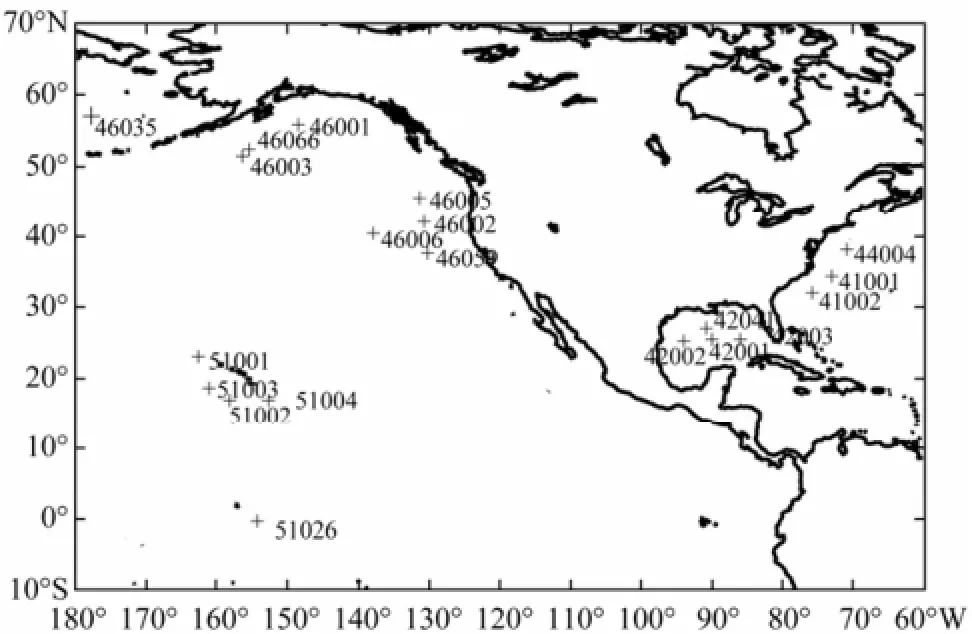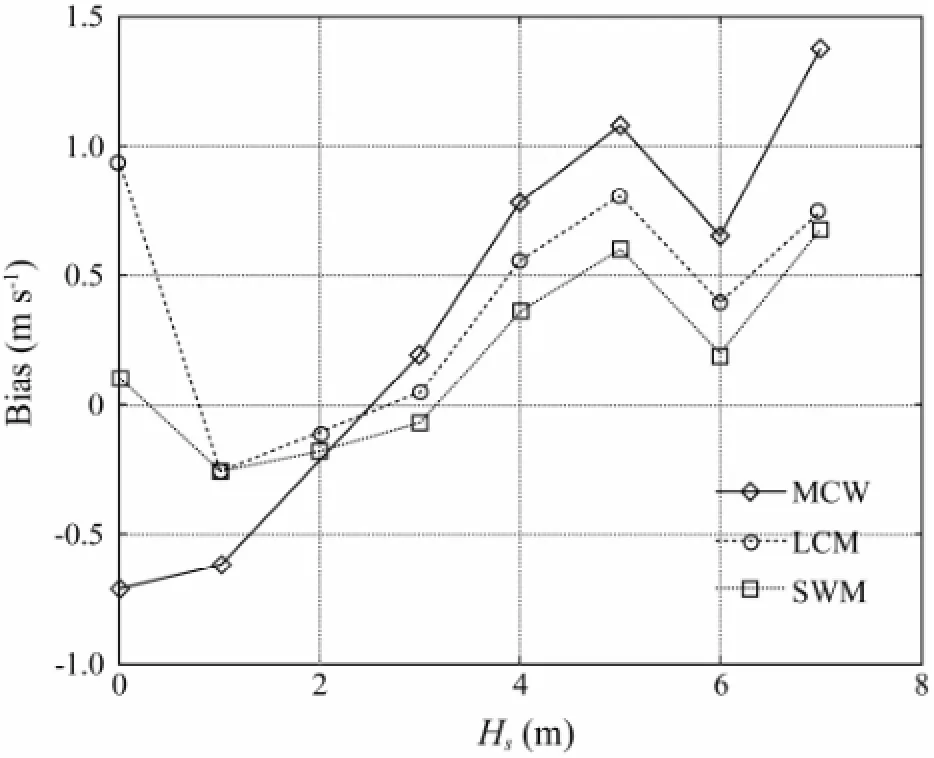A Physics-Based Dual-Frequency Approach for Altimeter Wind Speed Retrieval
2014-05-05LIShuiqingZHOULiangmingLIZhanbinMIAOQingshengMOULinandWANGAifang
LI Shuiqing, ZHOU Liangming,, LI Zhanbin, MIAO Qingsheng, MOU Lin, and WANG Aifang
1) Institute of Oceanology, Chinese Academy of Sciences, Qingdao 266071, P. R. China
2) Physical Oceanography Laboratory, Ocean University of China, Qingdao 266100, P. R. China
3) National Marine Data and Information Service, State Oceanic Administration of People’s Republic of China, Tianjin 300171, P. R. China
4) Engineering Reconnaissance and Design Institute, Ocean University of China, Qingdao 266100, P. R. China
A Physics-Based Dual-Frequency Approach for Altimeter Wind Speed Retrieval
LI Shuiqing1),2), ZHOU Liangming2),*, LI Zhanbin3), MIAO Qingsheng3), MOU Lin3), and WANG Aifang4)
1) Institute of Oceanology, Chinese Academy of Sciences, Qingdao 266071, P. R. China
2) Physical Oceanography Laboratory, Ocean University of China, Qingdao 266100, P. R. China
3) National Marine Data and Information Service, State Oceanic Administration of People’s Republic of China, Tianjin 300171, P. R. China
4) Engineering Reconnaissance and Design Institute, Ocean University of China, Qingdao 266100, P. R. China
The altimeter normalized radar cross section (NRCS) has been used to retrieve the sea surface wind speed for decades, and more than a dozen of wind speed retrieval algorithms have been proposed. Despite the continuing efforts to improve the wind speed measurements, a bias dependence on wave state persists in all wind algorithms. On the basis of recent evidence that short waves are essentially modulated by local winds and much less affected by wave state, we proposed a physics-based approach to retrieve the wind speed from the dual-frequency difference in terms of the mean square slope of short waves. A collocated dataset of coincident altimeter/buoy measurements were used to develop and validate the approach. Validation against buoy measurements indicates that the approach is almost unbiased and has an overall root mean square error of 1.24 m s-1, which is 5.3% lower than the single-parameter algorithm in operational use (Witter and Chelton, 1991) and 2.4% lower than another dual-frequency approach (Chenet al., 2002). Furthermore, the results indicate that the new approach significantly improves the wave-dependent bias compared to the single-parameter algorithm. The capacity of altimeter to retrieve sea surface wind speed appears to be limited for the case of winds below 3 m s-1. The validity of the approach at high winds needs to be further examined in the future study.
altimeter; mean square slope; dual-frequency; wind speed retrieval
1 Introduction
The ocean specular return received by the altimeter at Ku-band has been widely used to retrieve the sea surface winds for several decades. It is of special interest for its providing simultaneous measurements of surface winds and waves at global scale with high spatial resolution. For an isotropic rough surface of Gaussian distribution, the specular return in terms of normalized radar cross section (NRCS) can be expressed as (Valenzuela, 1978):

whereσ0is the NRCS. The altimeter works on dual- frequency:Ku-band at 13.6 (GHz) (σ0Ku) andC-band at 5.3 (GHz) (σ0C). In Eq.(1),ρnis an effective nadir reflection coefficient,s2is the mean square slope (MSS), which directly describes the sea surface roughness and is mainly determined by the surface waves induced by the winds. Generally, a higher wind speed corresponds to a rougher sea surface with a higher MSS value. Therefore, the sea surface wind speed could be retrieved from the NRCS directly by establishing an explicit relationship between wind speed at 10 m heightU10andσ0Ku, either by statistical techniques (Brown, 1978; Witter and Chelton, 1991) or by analytical methods (Wu, 1994; Hwanget al., 1998).
Based on continuing studies on the wind speed retrieval, it is found that a wave-dependent bias persists in the single-parameter algorithms (Glazman and Pilorz, 1990; Gommengingeret al., 2002). In order to account for the bias, an additional parameter is introduced besidesσ0Ku, for which the significant wave height (Hs) measured by the altimeter is generally used, and some improvements have been yielded in this way (Lefevreet al., 1994; Gourrionet al., 2002; Zhao and Toba, 2003; Liet al., 2013). However, Gourrionet al.(2002) argued that theHsis a limited proxy for variable wave conditions that have impact on the NRCS. In place ofHs, Chenet al.(2002) showed that theσ0Cappears to be more effective and they proposed a statistical approach using both theσ0Kuandσ0Cas input. Zhaoet al.(2012) also emphasized thatσ0Cshould be included in the winds retrieval.
Recent studies on the wave dependence of MSS appears to offer a new opportunity to improve the wind speed retrieval. Vandermarket al.(2004) suggested that the wave dependence of total MSS could be mainly ascribed to long-wave (wave length larger than 3 m) titling effect. We studied this with a collocated dataset of buoys and altimeter measurements, and found that the MSS of long gravity waves strongly depend on wave age, while the MSS corresponding to the rest short-waves are modulated dominantly by the surface winds (Liet al., 2013). These results imply that the sea surface wind speed could be more effectively retrieved from the MSS of shortwaves. Elfouhailyet al.(1998) proposed an analytical wind stress algorithm using theKu-Cband difference (i.e., MSSKu-MSSC), and an improved accuracy was derived comparing with the single-parameter algorithm (Witter and Chelton, 1991).
The goal of this study is to develop a new approach to retrieve wind speed from altimeter mean square slope of short-waves. In Section 2, the collocated dataset used in this study is described. The development of the approach is presented in Section 3. The validation and intercomparison are given in Section 4. Finally, conclusions are presented in Section 5.
2 Collocated Dataset
A dataset of collocated Topex/Poseidon (T/P) altimeter andin-situmeasurements was constructed. T/P provides NRCS measurements every second, corresponding to approximately a 6.8-km resolution along the satellite track. For theσ0Cmeasurements an additional correction was made to account for the atmosphere attenuation, following the procedures given by Frewet al.(2007). Quality checks were performed by eliminating the erroneous altimeter estimates based on the conventional data quality flagging suggested by Glazman and Pilorz (1990).
Thein-situmeasurements were obtained from the buoys operated by the U.S. National Data Buoy Center (NDBC), which were widely used as the sea truth for algorithm validation. In order to remove shallow water effects and the coastal sheltering, we chose the buoys located in deep water and at least 200 km from the land, as shown in Fig.1, and a total of 19 buoys were selected.

Fig.1 Locations of the NDBC buoys used in the dataset.
Some of the buoys measured the winds at the height of 5 m, and these winds were converted to those at 10 m based on the drag coefficient proposed by Wu (1980).
The collocated space and time windows were chosen to be 50 km and 1h as recommended by Chen and Lin (2001). In order to make the analysis more objective, separated datasets were used for the development and validation of the approach. The dataset for the method development ranges from January 2003 to August 2005, with a total of 2623 groups, while the dataset consisting of 914 pairs and covering the period from January 2001 to December 2002 was used for the method validation.
3 Development of the Approach

Based on the supported evidence that specular return from long-waves are strongly contaminated by wave state and that short waves are essentially perturbed by local winds (Vandermarket al., 2004; Liet al., 2013), we attempted to estimate wind speed from the MSS of short waves. The MSS can be obtained from the integration of wave spectrum (Phillips, 1977): whereis the wavenumber spectrum of ocean waves,wavenumber vector,kdis the cutoff wavenumber. Brown (1990) suggested that cutoff wavelength is nearly 3 times the incidence wave length, inferring that the cutoff wavenumber forKu-band andC-band are approximately 100 rad m-1and 40 rad m-1respectively. As a result, MSS in the range of 40–100 rad m-1can be derived from the dual-frequency difference:



Fig.2 Scatter diagram of buoy wind speeds vs MSS (40–100 m-1). The fitted relationship of Eq. (5) is shown with an overlaid curve.

Fig.3 Scatter diagrams of T/P versus buoy wind speeds. A 1:1 perfect line is also overlaid on each subplot. (a) MCW, (b) LCM and (c) SWM.
Based on regression analysis, the best fit is:

4 Comparison and Validation
In this section, the new approach is validated against the buoy measurements. The algorithms proposed by Witter and Chelton (1991) (denoted as MCW) and Chenet al.(2002) (denoted as LCM) are also used for comparison. The former is single-parameter based and operationally used for altimeter, while the latter uses both the NRCS ofKuandCband, which is regarded as one of the most accurate algorithms so far.
The scatter diagrams of altimeter winds with respect to the buoy winds are shown in Fig.3, together with the meanbias and root mean square error (RMSE) of the three algorithms. Compared to the MCW results, the SWM and LCM results are more concentrated with respect to the 1:1 perfect line, especially at low winds. The SWM performs best in terms of both mean bias and RMSE, with almost unbiased estimates and reduced RMSEs of 5.3% and 2.4% compared to MCW and LCM, respectively.
Fig.4 shows the probability distribution function (PDF) of winds from the buoy measurements, as well as the altimeter estimates by the three algorithms. The discrepancy between the measurements by the buoy and altimeter mainly occurs for the moderate winds (5–9 m s-1). The altimeter favors more the wind speed around 6 m s-1and less the wind speed around 8 m s-1. the SWM is seen to represent a medium case among the three algorithms.

Fig.4 Probability distribution functions of wind speeds by buoy, MCW, LCM and SWM.
The wave-dependent biases in the three algorithms are also examined. Fig.5 shows the bin-averaged bias versus SWH. It is obvious that the MCW biases correlate with the SWH, which underestimates the wind speed with small waves and overestimates the wind speed with high SWH. This trend is largely reduced by both LCM and SWM, indicating thatσ0Cis effective for improving the wave-dependent bias.

Fig.5 The bin-averaged wind speed bias versus SWH.
Both the LCM and SWM show improvements over the MCW due to the use ofσ0Cas input. Chenet al.(2002) found a close correlation among the three parameters (σ0Ku,σ0C,U10) from a statistical point of view, while our algorithm may explain their inner relationship and gives more accurate results; the LCM may be limited to the data used for the development of algorithm. Furthermore, the SWM is much simpler in form and is expected to be more applicable in practical use.
It should be mentioned that both the MCW and LCM were not designed for wind speed above 20 m s-1, and it was also not clear whether the SWM could be effectively extrapolated to the high winds due to the lack of observations. Based on the wind speed estimated from a typhoon model, Young (1993) and Guet al.(2011) proposed high winds algorithms in a linearU10-σ0Kurelationship independently, termed as Y1993 and G2011, respectively. Fig.6 shows the two high winds relations, as well as that for the SWM, which was constructed from the measurements of T/P cycles 232-247. A large discrepancy can be seen between Y1993 and G2011, which increases with decreasingσ0Kuand is as large as about 8 m s-1atσ0Ku=6.0 dB. The SWM results are seen to be close to those in G2011, and the spreading band at a givenσ0Kumay account for the wave-dependent bias. Zhao (2002) suggested that the wave effect is even obvious under high winds conditions, andis expected to be a more appropriate candidate for high winds retrieval in this sense.

Fig.6 The high-wind relationship of U10and σ0Kufrom Young (1993), Gu et al. (2011) and SWM.
5 Concluding Remarks
The retrieval of wind speed from altimeter measurements has been studied for decades, with more than a dozen of algorithms having been proposed for such purpose. The accuracy is limited as a wave-dependent bias typically exists in the retrieval. Based on the physical characters of MSS of short waves, we developed a newapproach (SWM) to estimate the wind speed from the altimeter dual-frequency NRCS difference. The RMSE of the SWM is 1.24 m s-1, 15% relative to the mean wind speed. Compared with the MCW and LCM, it has a reduction of RMSE of 5.3% and 2.4%, respectively. The wave-dependent bias is reduced in comparison with the single-based MCW. However, the approach is limited at wind speeds below 3 m s-1, which may be due to the fact that such winds do not efficiently contribute to the MSS of short waves in this range.
The high wind speed retrieval from the altimeter is of special interest as it provides simultaneous wind/wave measurements, which makes it very useful in the studies of wave growth and air-sea interaction (Chen et al., 2002). We showed that there is a large discrepancy in the existing σ0Ku-based high wind algorithms, which appears to be partly attributed to the wave-dependent bias. Since the wave conditions are expected to be more complicated at high winds, the MSS of short waves appears to be a more proper candidate than σ0Ku. Thetionship at high winds needs to be further studied and validated in the future study.
Acknowledgements
This work is supported by the National High Technology Research and Development Program of China (2013 AA09A505). TOPEX altimeter and buoy data are provided by the NASA TOPEX/POSEIDON Project and the National Data Buoy Center.
Brown, G. S., 1978. Estimation of surface wind speeds using satellite-borne radar measurements at normal incidence. Journal of Geophysical Research, 84 (B8): 3974-3978.
Brown, G. S., 1990. Quasi-specular scattering from air-sea interface. In: Surface Waves and Fluxes. Geerneart, G., and Plant, W., eds., Springer Press, New York, 1-40.
Chen, G., Chapron, B., Ezraty, R., and Vandemark, D., 2002. A dual-frequency approach for retrieving sea surface wind speed from TOPEX altimetry. Journal of Geophysical Research, 107 (C12): 3226-3235.
Chen, G., and Lin, H., 2001. Impacts of collocation window on the accuracy of altimeter/buoy wind-speed comparison–A simulation study. International Journal of Remote Sensing, 22 (1): 35-44.
Cox, C., and Munk, W., 1954. Measurement of the roughness of the sea surface from photographs of the sun’s glitter. Journal of the Optical Society of America, 44: 838-850.
Elfouhaily, T., Vandemark, D., Gourrion, J., and Chapron, B., 1998. Estimation of wind stress using dual-frequency TOPEX data. Journal of Geophysical Research, 103 (C11): 25101-25108.
Frew, N. M., Glover, D. M., Bock, E. J., and McCue, S. J., 2007. A new approach to estimation of global air-sea gas transfer velocity fields using dual-frequency altimeter backscatter. Journal of Geophysical Research, 112, C11003, DOI: 10. 1029/2006JC 003819.
Glazman, R. E., and Pilorz, S. H., 1990. Effects of sea maturity on satellite altimeter measurements. Journal of Geophysical Research, 95 (C3): 2857-2870.
Gommenginger, C., Srokosz, M., Challenor, P., and David, C., 2002. Development and validation of altimeter wind speed algorithms using an extended collocated buoy/topex dataset. IEEE Transactions on Geoscience and Remote Sensing, 40 (2): 251-260.
Gourrion, J., Vandemark, D., and Bailey, S., 2002. A two-parameter wind speed algorithm for Ku-band altimeters. Journal of Atmospheric and Oceanic Technology, 19 (12): 2030-2048.
Gu, Y., Liu, Y., Xu, Q., Liu, Y. H., Liu, X. Y., and Ma, Y. J., 2011. A new wind retrieval algorithm for Jason-1 at high wind speeds. International Journal of Remote Sensing, 32 (5): 1397-1407.
Hwang, P. A., Teague, W. J., Jacobs, G. A., and Wang, D. W., 1998. A statistical comparison of wind speed, wave height, and wave period derived from satellite altimeters and ocean buoys in the Gulf of Mexico region. Journal of Geophysical Research, 103 (C5): 10451-10468.
Lefevre, J. M., Barckicke, J., and Ménard, Y., 1994. A significant wave height dependent function for TOPEX/POSEIDON wind speed retrieval. Journal of Geophysical Research, 99 (C12): 25035-25049.
Li, S., Zhao, D., Zhou, L., and Liu, B., 2013. Dependence of mean square slope on wave state and its application in altimeter wind speed retrieval. International Journal of Remote Sensing, 34 (1): 264-275.
Phillips, O. M., 1977. The Dynamics of the Upper Ocean. 2nd edition. Cambridge University Press, New York, 336pp.
Valenzuela, G. R., 1978. Theories for the interaction of electromagnetic and oceanic waves–A review. Boundary-Layer Meteorology, 13 (1): 61-85.
Vandemark, D., Chapron, B., Sun, J., Crescenti, G. H., and Graber, H. C., 2004. Ocean wave slope observations using radar backscatter and laser altimeters. Journal of Physical Oceanography, 34 (12): 2825-2842.
Witter, D. L., and Chelton, D. B., 1991. A geosat altimeter wind speed algorithm and a method for altimeter wind speed algorithm development. Journal of Geophysical Research, 96 (C5): 8853-8860.
Wu, J., 1980. Wind-stress coefficients over sea surface near neutral conditions–A revisit. Journal of Physical Oceanography, 10 (5): 727-740.
Wu, J., 1994. Altimeter wind and wind-stress algorithms–Further refinement and validation. Journal of Atmospheric and Oceanic Technology, 11 (1): 210-215.
Wu, J., 1996. Air–sea gas transfer: Mechanisms and parameterization. Journal of Physical Oceanography, 26 (8): 1440-1447.
Young, I. R., 1993. An estimate of the geosat altimeter wind speed algorithm at high wind speeds. Journal of Geophysical Research, 98 (C11): 20275-20285.
Zhao, D., Li, S., and Song, C., 2012. The comparison of altimeter retrieval algorithms of the wind speed and the wave period. Acta Oceanologica Sinica, 31 (3): 1-9.
Zhao, D., and Toba, Y., 2003. A spectral approach for determining altimeter wind speed model functions. Journal of Oceanography, 59 (2): 235-244.
Zhao, D., 2002. A note on wave state dependence of sea-surface roughness. International Offshore and Polar Engineering Conference. Kitakyushu, Japan, 26-31.
(Edited by Xie Jun)
(Received March 19, 2013; revised May 7, 2013; accepted January 14, 2014)
© Ocean University of China, Science Press and Springer-Verlag Berlin Heidelberg 2014
* Corresponding author. Tel: 0086-532-66781511
E-mail: zhou5299@ouc.edu.cn
杂志排行
Journal of Ocean University of China的其它文章
- Numerieal Prediction of Storm Surge in the Qingdao Area Under the Impact of Climate Change
- Warmer-Get-Wetter or Wet-Get-Wetter? A Criterion to Classify Oceanic Precipitation
- Modeling Seasonal Variations of Subsurface Chlorophyll Maximum in South China Sea
- Assimilation of High Frequency Radar Data into a Shelf Sea Circulation Model
- CFD-Based Numerical Analysis of a Variable Cross-Section Cylinder
- Extracting the Subsonic Anti-Symmetric Lamb Wave from a Submerged Thin Spherical Shell Backscattering Through Iterative Time Reversal
